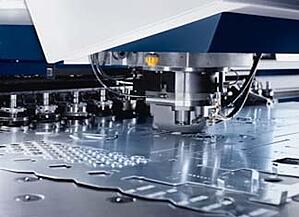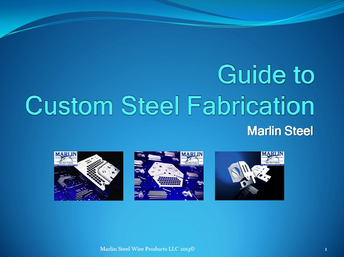 Sheet metal fabrication is a major part of Marlin’s custom basket manufacturing process. Many of Marlin’s custom wire baskets feature custom-cut and shaped sheet metal components, including hinges for basket lids, custom-sized basket frames, and even entire baskets made from punched sheet metal plates.
Sheet metal fabrication is a major part of Marlin’s custom basket manufacturing process. Many of Marlin’s custom wire baskets feature custom-cut and shaped sheet metal components, including hinges for basket lids, custom-sized basket frames, and even entire baskets made from punched sheet metal plates.
To create the perfect custom sheet metal forms, Marlin’s degreed engineers use heavy-duty sheet metal punching machines. However, simply having the machine doesn’t guarantee top-quality sheet metal forms. Knowing how to punch holes in sheet metal properly using the right techniques is a crucial part of the “secret sauce” that enables Marlin’s manufacturing team to make parts that can consistently meet tight tolerances.
Here are a few of the manufacturing team’s top sheet metal punching strategies that they use on a daily basis:
1: Calculating Maximum Inside Bend Radii
For every metal work piece, there’s a maximum tightness to which it can be bent before the integrity of the piece is compromised. Bending sheet metal too tightly creates weak points that may break more easily than intended. However, there’s no set standard to how tight the inside radius of a bend can be—it’s a variable that’s affected by several properties of the work piece (such as the metal’s hardness and thickness).
One article from The Fabricator recommends that you “divide 50 by the material’s tensile reduction percentage” and then “subtract 1 from that answer” and “multiply that answer by the plate thickness” to help you determine the smallest inside radius for a bend in inches. For example, a 2” thick steel plate with a reduction percentage of 20% would have a minimum inside bend radius of 3”, or 50% more than the material’s thickness (50/20 = 2.5, -1 = 1.5, *2 = 3”).
It’s also important to consider the “grain” of the material when making a bend, as this can influence how well the material conforms to the bend as well as the potential for springback. This calculation is useful for machinery other than CNC punches as well—Marlin’s degreed engineers frequently have to calculate inside bend radii when using the CNC press brake.
2: Minimizing Heat Generation to Prevent Galling
Galling, or the adherence of a work piece to the sheet metal punch machine, can be a major problem when punch operations are rushed or both the punch and the sheet metal are made of similar materials.
As CNC punches bend metal, the friction can cause a buildup of heat and, when the metal makes contact with a similar piece of metal, they may partially fuse. This is somewhat similar to the process for welding, but it’s an unintentional side effect of the punch process, not the goal. To minimize friction and heat buildup, Marlin’s degreed engineers use a few different techniques, including:
- Letting the punch rest between uses;
- Applying coatings to the punch tool;
- Using back taper motions to minimize contact duration; and
- Using multiple punch heads to distribute heat stress.
These measures can all help to prevent galling. This, in turn, helps to maximize both productivity and part accuracy, since there’s less risk of fouling the work piece or the tool.
3: Using Laser Cutting for Making Simple Holes
One common issue when using a CNC punch to make holes in metal is that there will always be a slight bit of deformation at the edge of the hole from the tooling used to cut it. Additionally, if the tool has a smooth surface, there’s a chance that the slug, or the discarded metal from the punched hole, can stick to the tooling and foul up the punching process. Plus, using a sheet metal punching machine for making basic holes puts extra wear and tear on the machine.
So, Marlin’s degreed engineers often use a separate CNC laser cutting machine when basic holes are needed in a custom sheet metal form. Because there’s no physical contact, the laser cutter doesn’t wear out like a punch does, and it can make perfectly smooth holes without any of the distortion that a punch creates by shearing nearby material. This also neatly avoids the risk of punched slugs sticking to the die.
Instead, the sheet metal punch can be saved for making holes where the excess material needs to be bent into a specific shape.
4: Post-Punch Deburring
As with any mechanical parts cutting and shaping process, sheet metal punching can create sharp edges and burrs from time to time. So, to eliminate these burrs and sharp edges, Marlin Steel’s manufacturing team uses a couple of post-forming deburring processes:
- Wet and Dry Sanding. Marlin has a few large scale sanding machines that can grind down rough edges on a sheet metal work piece both quickly and consistently.
- Electropolishing Processes. Electropolishing strips the surface layer of a sheet metal form, leaving only a microscopically-smooth surface that is stronger and easier to clean. Many custom metal forms made for the pharmaceutical and food industries get electropolished.
These deburring processes help to minimize the risk of injury to anyone handling the sheet metal forms later on. In the case of electropolishing, the sheet metal form can even become more suitable for specific tasks thanks to the enhanced surface condition of the part.
There are many more tricks and tools that the Marlin manufacturing team uses to craft the perfect custom sheet metal forms for clients. Do you need a custom wire basket or sheet metal form as soon as possible? Reach out to Marlin Steel to get started.



.gif)


